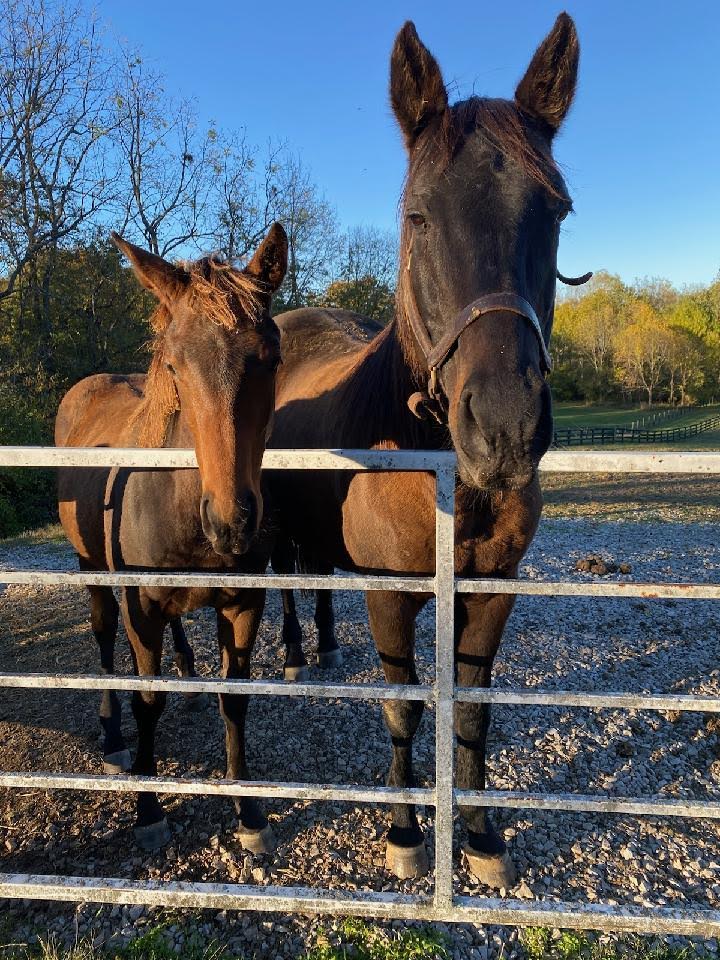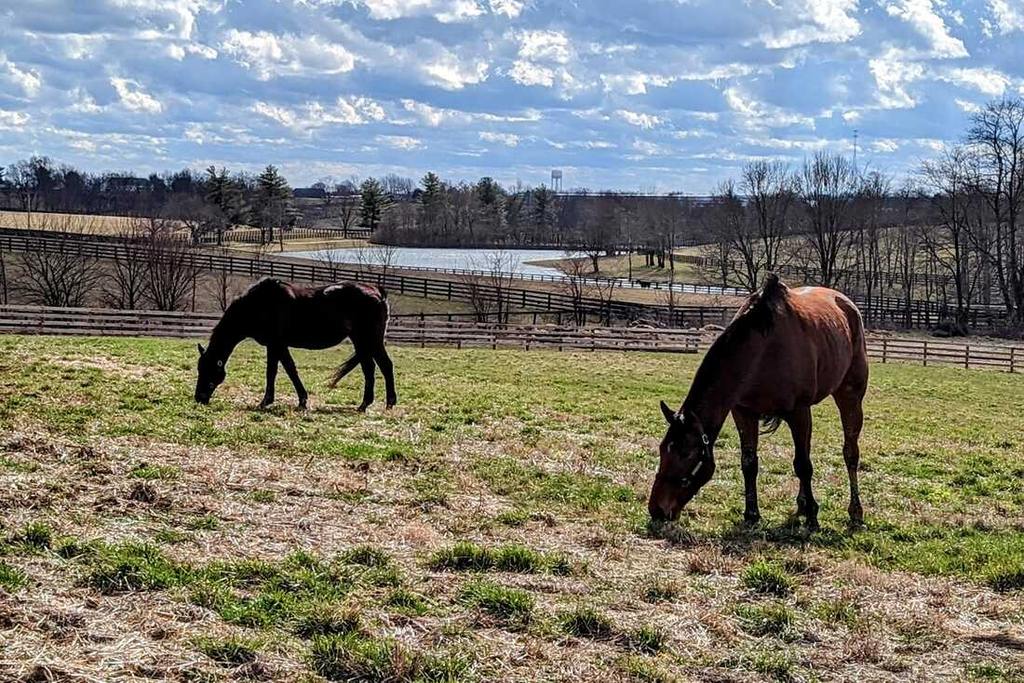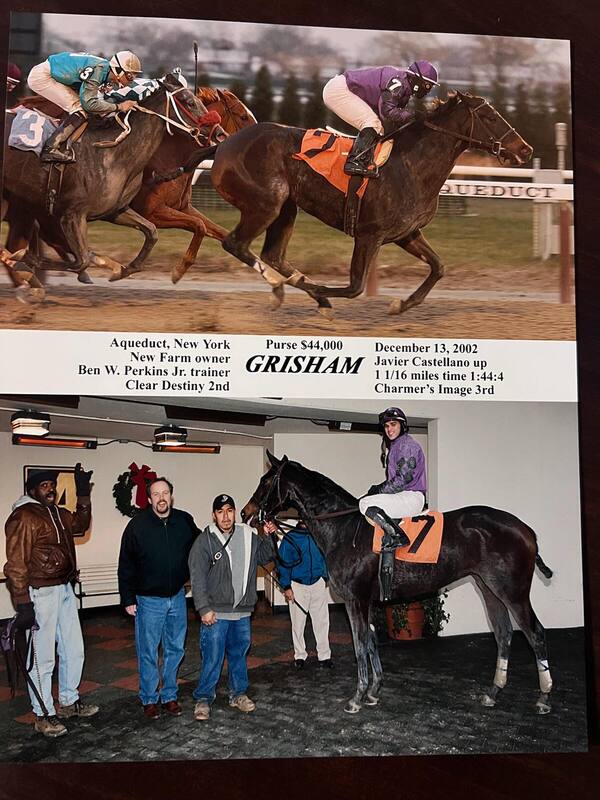
Grisham and her ward, Tempo – November 2023. (Mareworthy Photo)
24-year-old Thoroughbred broodmare has beaten the odds
By Scot Gillies
November 14, 2023, marks one year from the date Grisham’s bail was paid and she was rescued from a notorious “kill pen” in Pennsylvania.
This is the story of one Thoroughbred broodmare retiree. To many in the racing and breeding industry, hers is a typical tale that varies only in a few details from the mundane life narrative of thousands of other mares. Like so many Thoroughbreds, Grisham started as a pinhook, waged a racing campaign, served a long broodmare career, and eventually reached an uncertain retirement.
But only weeks away from turning a quarter-century, and only a year removed from an ambiguous fate while relegated to an auction kill pen, Grisham has a story with a few surprises.
Born in 1999, when the U.S. foal crop numbered 33,844—almost precisely twice the expected foal count in 2023—Grisham never broke into the upper echelons of the sport. Nevertheless, she has lived a life of beating the odds, if only slightly.
- She sold for a fair price. Bred commercially, Grisham was a $60,000 weanling auction purchase at 5 months old and immediately became a pinhook prospect. When she went through the sales ring 11 months later as a 2000 yearling, she brought a winning bid of $72,000—well above that year’s $13,000 median and $59,360 average prices for sold yearlings.
- She ran and won. Somewhere between half and three-quarters of Thoroughbred foals ever make it to the starting gate, and only 40 percent to 70 percent of runners ever win a race. Fewer still are able to score beyond the claiming ranks, or to make a repeat appearance in the winner’s circle. Grisham accomplished all of those feats.
- She had one owner. Almost all Thoroughbred racemares are sold before their new broodmare career, and most broodmares change hands several times during their productive years—either sold for a profit after producing well or culled when their foals are underperforming expectations. Atypically, for her entire racing and breeding career, Grisham had only one owner.
- She has produced more foals than average. Because of their own age and health, or because of diminishing class or value of offspring, most broodmares stop after producing five to nine foals. With her 14 colts and fillies, Grisham exceeded the average considerably.
- Her foals have raced and won. If somewhere less than half of Thoroughbred foals end up winning a race in their lifetimes, it might be reasonable to expect six of Grisham’s offspring would be winners. Instead, nine already have won and two more—her unstarted foals of 2021 and 2022—are still in the racing pipeline.
- Her foals are showing more than average class. Grisham has never had a true star offspring, but one colt placed in a Grade I contest, and five of her foals already have earned more than $100,000.
- She was rescued. When the odds broke against her in late 2022 and she found herself abandoned to the doom of the kill pen, Grisham again beat the odds: She was rescued. Unfortunately, “kill pen” is an apt name, as most horses discarded to these low-level auctions end up bound for slaughter.
Grisham’s background
Bred in Kentucky by Lantern Hill Farm, Grisham was the 11th of 14 foals out of the stakes-producing Sham mare Sham Street and came from the second crop of Kentucky Derby-winning Grindstone. Her name—a portmanteau pulling the first three letters from the name of her sire and the remaining four letters from her dam—may have been inspired also by the author John Grisham, whose legal thrillers were among the hottest bestsellers in the decade of Grisham’s birth.
Grisham was foaled May 25, 1999, and almost immediately began her first “career” as a racing and pinhook prospect. (Often weaned earlier than non-sale-bound foals, fillies and colts bred for the sales ring tend to have a less carefree upbringing than their homebred racing counterparts. Those foals purchased as weanling-to-yearling or yearling-to-juvenile pinhooks typically spend extended stretches of time in the barn to avoid injuries and sun bleaching; they receive considerable extra handling for sales prep; and they often undergo a regimen of muscle-building supplements and exercises intended to improve their appearance in the auction ring. For some foals, this early “career” as a sales prospect can start as early as their third month and can extend beyond their second birthday.)
Grisham had not yet reached six months when she first went through the ring at Keeneland. Picked up for $60,000 by York Bloodstock as a pinhook prospect, Grisham was shipped to Florida, where she was next offered at the 2000 OBS August yearling sale and RNA’d after a final bid of $47,000. Whether she subsequently exited a gawky stage or buyers were just more receptive in Kentucky, Grisham’s walk through the ring at Fasig-Tipton’s October sale only two months later was more successful, achieving a sale price of $72,000. Her buyer, New Farm, would be her owner throughout her years on the track and in the broodmare barn.
Grisham’s racing and breeding careers
The dark bay Grisham saw modest success as a racehorse, winning two of 11 starts, all at age 3 while running under the colors of New Farm for trainer Benjamin Perkins Jr. As a late foal of 1999, she began race training shortly after her true second birthday and was ready for her first start in mid-January 2002. After she placed twice in her first four starts, her first win came in a maiden special weight at Delaware Park about a week and a half shy of her actual third birthday in May 2002. Six races and seven months later, she went out a winner again, scoring in a mid-December allowance at Aqueduct. Both of Grisham’s wins were over 8.5 furlongs on the dirt. She ended her racing career with earnings just shy of $75,000 from two wins and five shows.
Retired from her second career as a racemare, Grisham immediately transitioned into her new role as a broodmare. First bred as a 4-year-old in 2003, Grisham would go on to produce 13 registered foals (plus another that died) between 2004 and 2022. So far, nine of her offspring are winners—all of them have annexed multiple races, in fact—and two others are still young foals whose race careers are ahead of them. Of her remaining two offspring, one started but did not win, and another was registered but never named. Five of Grisham’s 10 runners have surpassed six figures in earnings, a remarkable rate of success. Her top performer, the 2006 Forest Wildcat son Wildcat Brief, was a stakes winner and placed in the grade I Vosburgh Stakes at Belmont in 2010.
Grisham’s travels
Herself a Kentucky-bred, Grisham’s racing and breeding careers saw her traveling frequently. Within an 11-month period as a weanling and yearling, she went through auction rings in Kentucky, Florida, and back in Kentucky. At 3, she raced in Delaware, Maryland, and New York. As a broodmare, she was shuttled between Kentucky, Florida, Maryland, and New Jersey as she followed New Farm-owned stallions when they moved between those locations. And her darkest moment came at age 23 in Pennsylvania, when she was herded into a feed lot pen with bleak prospects.
Grisham’s fast fall and surprising rescue
Owned for nearly 22 years by New Farm—from autumn 2000 when she was purchased as a yearling to age 23 when she weaned her 2022 filly—Grisham was retired from the broodmare herd in mid-2022. New Farm manager and trainer Gene Moore, who had started Grisham as a weanling and oversaw her long broodmare career, says she was placed with an individual who promised her a loving permanent home. Lamentably, within months, the then-23-year-old mare descended into the dark side of the Thoroughbred breeding game. Seven months after foaling a chestnut filly by Rainbow Heir, Grisham was hip 288 in a feedlot sale. Inmates of Pennsylvania’s notorious “kill pens” are often destined to be considered by slaughter buyers for their meat value.
Occasionally, one of several equine charities is able to rescue a Thoroughbred from this wretched fate. On November 14, 2022, a social media follower of Mareworthy alerted the Thoroughbred broodmare rescue facility of Grisham’s predicament. Kyle Rothfus’s newly established program was still seeking 501(c)(3) certification at the time and was focused on rehoming broodmares directly from farms in Central Kentucky, so a feedlot rescue in Pennsylvania, with only 24 hours’ notice to make logistical and financial arrangements from afar, required extraordinary efforts to pull off. On November 15, Mareworthy was able to post Grisham’s “bail” or “ransom” and arrange for her to begin a six-week quarantine at a farm in Pennsylvania before she would be well enough to travel to the Mareworthy sanctuary.
On January 2, 2023, at age 24, Grisham returned home to Central Kentucky. Caregivers at Mareworthy continued the Pennsylvania quarantine facility’s work of restoring the senior mare to a healthy weight—and also faced the larger challenge of reestablishing the retiree’s confidence after her harrowing experiences of the prior year.
With calm, consistent, and gentle handling, Grisham blossomed. As her ribs disappeared and her dull coat became glossy and dappled, her spirit returned as well. Soon, Grisham was galloping across the paddock at a speed belying her age, often outpacing mares many years her junior as she soaked up the sun and green grass and—finally—got a chance to just be a horse.

Grisham’s fourth career as a nanny
When Kyle Rothfus made the decision to rescue Grisham from the feed lot, he was certain the old bay mare would become a permanent fixture at Mareworthy. While the facility specializes in rehoming retired broodmares, he knew the typical adoptee was a decade younger than Grisham. Most adoptors ask for mares as riding prospects—and, with more than two decades elapsed since Grisham last had a rider on her back, she was not a likely candidate for reschooling.
But carrying a rider isn’t the only job for a horse, and Grisham’s 14 foals gave her a lifetime of experience for a new role: nanny.
This past summer, I found myself in need of a companion horse who could provide comfort to newly weaned foals. We had lost my previous ex-broodmare adoptee—the 29-year-old mare Since Time Began—in the spring, and with her passing I no longer had a prospective companion for my 2023 filly, who was due to be weaned in early autumn.
While researching possible fits for the nanny role, I learned about Mareworthy. And I was impressed! Here were two dedicated horsemen with a newly-established local rescue devoted to broodmare retirees—a soft spot in my own horse-loving heart. And on the Mareworthy website, I saw a profile of this 24-year-old who had raised so many foals of her own that she would be a natural with youngsters needing guidance. It seemed like a potential match, so my wife and I arranged to visit Mareworthy. I think Kyle was surprised when he showed us several younger mares that could serve as nannies and we kept steering the conversation back to Grisham.
Grisham arrived at our small farm, Mare Croft, on August 21. After a quarantine period, she met our little herd, including the suckling filly who would become her charge when weaned a couple of months later. Grisham was deferential to the other mares, and immediately formed a relationship with our filly, Tempo, that carried over to weaning. Today, the two are close companions, and Grisham is helping to teach the filly about all the important things in life: Finding the best flakes of hay, putting butts to the wind during the first cold snap of the year, racing to the gate at feeding time, and occasionally tearing up and down the hill just for the fun of it.
With only months until her quarter-century, Grisham knows what she likes in life. She wants extra attention paid to her chest and withers during her daily grooming, and then enjoys a good roll in the dust or mud after being brushed. She’ll take as many carrots as she’s offered but wants only one mint at a time and turns up her nose entirely at bananas and apples. She’s okay with being separated for meals but will complain if she’s left alone too long in the paddock or in her stall. She enjoys having her udder cleaned except when she’s in heat and especially sensitive—and then beware: All bets are off on her kind and gentle nature!
We’re so grateful to Grisham for the wonderful nanny she’s been and expect her to be the companion of weanlings for years to come. We are also incredibly indebted to Mareworthy for sharing Grisham with us. We plan to be her final soft-landing spot in life, but Kyle assures us she will always have a home at Mareworthy so she has an extra safety net for her golden years.
Reprinted by permission of Mareworthy. For additional photos of Grisham’s transition click here.
About the Author
Scot Gillies is the owner of Mare Croft, a small breeding farm in Kentucky, where he typically has one or two adopted Thoroughbred ex-broodmares as companions and nannies. He is a former editor of The Blood-Horse MarketWatch and wrote about responsible breeding and broodmare retirement in The Five-Cross Files blog.



